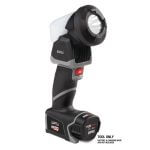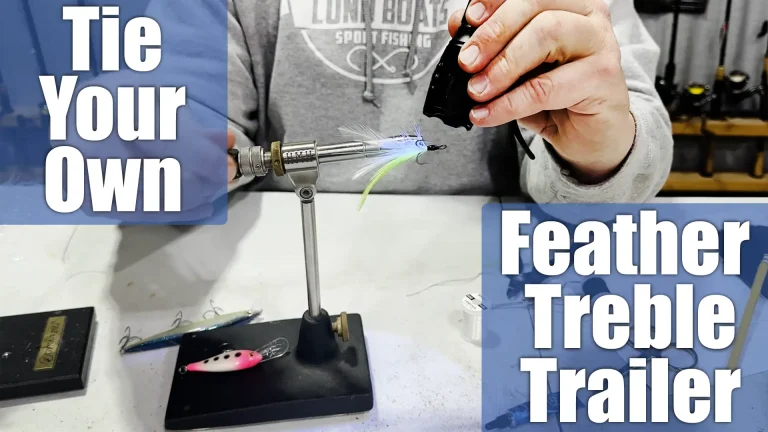Here we will discuss how to properly spool a spinning reel. Spooling a spinning reel can be a bit challenging due to line twists, but if done correctly, it can lead to an enjoyable fishing experience. While there are products available on the market to help with spooling, we will focus on the manual process. So, let’s get started!
Choosing the Right Line To Spool a Spinning Reel
Before we begin spooling, it’s important to choose the right line for your spinning reel. There are two main types of line: super line and monofilament/fluorocarbon. Superline is commonly used with a fluorocarbon leader, while monofilament/fluorocarbon can be used on its own. It’s important to note that while superline may have wind knot issues, monofilament/fluorocarbon can be more troublesome. For this demonstration, we will be using monofilament.
Spooling the Line
To start spooling the line, make sure the line is coming off the spool counterclockwise. Lay the line flat and thread it through the first guide of the rod. Open the bail and create a uni knot by creating a loop with the tag end of the line. Take the tag end and push it back towards your fingers to create another loop. Hold the tag end with your thumb and forefinger and wrap it around the loop two to four times. Pull the tag end to tighten the knot and then clip off the excess.
Next, place a small piece of electrical tape on the spool. This is not necessary for monofilament/fluorocarbon, but it is essential for super line to prevent the line from spinning. Close the bail manually to prevent line twists.
Now, it’s time to start spooling the line. Tighten the drag on the reel and use medium tension to hold the line between your fingers. Begin reeling in the line, flipping the reel over back and forth a few times to ensure the line goes on the spool evenly. Monitor the line as it comes off the factory spool to ensure it is spooling correctly.
A helpful tip is to place the spool of line in a bucket of water or sink. This can help prevent line twists and make the spooling process smoother. Be careful not to overfill the spool, leaving about an eighth of an inch of space at the top. Overfilling or underfilling the spool can cause issues when casting.
Once you have enough line on the reel, attach the line to the handle using a clip. It’s important not to overfill the spool, as it can cause the line to explode off the reel when the bail is opened.
Spinning Reel Spooling Maintenance Tips
To keep your spinning reel and line functioning properly, there are a few maintenance tips to consider. One option is to use a product like Real Magic, which can be sprayed on the line to improve its performance. Another option is to stretch the line after a fishing trip to remove any twists. Attach the end of the line to a tree or boat trailer and back up to create tension. Give the line three stretches and then reel it back in. This will help reduce memory in the line.
If you’re on the water and notice line twists, let out as much line as you want and reel it back in with tension on the reel. This can help untwist the line and save your fishing day.
Is it necessary to use the suggested technique, or is it just a helpful suggestion?
Using the suggested technique is not a requirement but rather a helpful suggestion that can significantly enhance your fishing experience. Trying out this method with a basic crockpot can streamline your spooling tasks and improve the performance of your fishing reel. Share your feedback on our Facebook page after giving it a try!
What are the benefits of using a crockpot lid to spool a spinning reel?
Using a crockpot lid to spool a spinning reel offers several advantages. Firstly, it provides a tidy and organized method for spooling your reel, eliminating the mess typically associated with traditional spooling methods using water bowls. The closed design of the crockpot lid allows for spooling indoors in any room, making it a convenient and versatile option. Furthermore, the rubber grommet insert in the crockpot lid serves to protect the fishing line from potential damage and reduces friction during the spooling process, ensuring that the line is smoothly and evenly distributed onto the reel. This technique results in a tightly packed line with minimal memory, ultimately enhancing the overall performance of the reel while simplifying the spooling process. In sum, utilizing a crockpot lid for spooling is an intelligent and efficient approach that can significantly improve your fishing experience by providing a hassle-free and effective way to spool your spinning reel.
How can a rubber grommet help in spooling a spinning reel?
A rubber grommet can be extremely helpful when spooling a spinning reel because it acts as a protective barrier for the fishing line. When using a crockpot to spool the line, a metal insert in the lid can cause unnecessary friction and damage to the line, similar to using sandpaper on it. However, a rubber grommet is a much more gentle material that can prevent this damage and ensure the smooth transfer of the line onto the spinning reel.
The rubber grommet inserted into the steam hole of a glass crockpot lid serves as a buffer between the line and the lid, minimizing friction and potential line failure. By using a rubber grommet, anglers can spool their spinning reels without worrying about their fishing line getting damaged. This simple yet effective solution can make the spooling process smoother and help maintain the integrity of the fishing line for successful angling trips.
How can you spool a spinning reel using a crockpot lid?
To spool a spinning reel using a crockpot lid, you can use a rubber grommet to prevent damage to your fishing line. Avoid using metal inserts as they can cause significant friction and harm the fishing line. A glass crockpot lid with a steam hole that has a rubber grommet insert is ideal for this method. The rubber grommet will protect the line and minimize friction, ensuring that the line remains intact during the spooling process. By following these steps and using the appropriate materials, you can effectively spool your spinning reel using a crockpot lid without compromising the integrity of your fishing line.
How does placing the spool of line in warm water help in preventing line twist and other common line management issues?
Placing the spool of line in warm water helps prevent line twist and other common line management issues by relaxing the line, making it more pliable and less prone to twisting during the spooling process. This method can contribute to smoother line management and better performance of spinning reels.
What practical method can be used to counteract line twist and other common line management issues while spooling spinning reels?
To counteract line twist and other common line management issues while spooling spinning reels, it is crucial to place the spool of line in warm water to help relax the line before spooling. This method can minimize line twist and improve overall line management.
What personal experience or anecdote can be shared to illustrate the effectiveness of using warm water during spooling?
The excerpt shares a personal anecdote of spooling spinning reels in elementary school using warm water to relax the line. This experience highlights the practicality and effectiveness of using warm water to prepare the line for fishing trips.
How can warm water be used to relax the line and minimize line twist when spooling spinning reels?
Warm water can be used to relax the line and minimize line twist by placing the spool of line in warm water, which helps to relax the line before spooling it onto the spinning reel. This method has been known to be effective in reducing line twist and other common line management issues.
In spooling spinning reels, common issues include line twists, wind knot problems with superline, and troubles with monofilament/fluorocarbon lines. To minimize these issues, it’s essential to choose the right line for your spinning reel and spool it correctly. When spooling, ensure the line comes off counterclockwise, use a uni knot to secure the line, and apply medium tension while reeling to prevent uneven spooling. Remember that placing the spool in water can help prevent line twists, and regular maintenance like using products to improve line performance and stretching the line after fishing trips can keep your spinning reel in optimal condition. Taking these steps will ensure a smoother fishing experience and help you tackle common line management issues effectively.
Conclusion
Spinning Reel Spooling may seem challenging, but by following these simple steps, you can do it yourself and have a great fishing experience. Remember to choose the right line, spool it correctly, and perform regular maintenance to keep your spinning reel and line in optimal condition.
Daiwa Tatula MQ LT
St. Croix
Sufix
Maluna Coolers
Real Magic Blakemore















